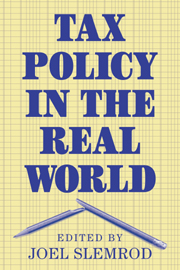Book contents
- Frontmatter
- Contents
- List of contributors
- 1 The real world of tax policy
- 2 Federal tax reform
- 3 Federalism and subfederal taxes
- Threading the fiscal labyrinth: some issues in fiscal decentralization
- A policymaker's guide to fiscal decentralization
- Fiscal decentralization and economic development
- Federalism and reductions in the federal budget
- Issues raised by the new federalism
- Fiscal equalization and school finance
- The case for equalizing aid
- Fiscal equalization: an empty box?
- How would you know a good economic development policy if you tripped over one? Hint: don't just count jobs
- Jobs, productivity, and local economic development: what implications does economic research have for the role of government?
- 4 Principles, politics, and the professors
- Index
A policymaker's guide to fiscal decentralization
Published online by Cambridge University Press: 01 June 2010
- Frontmatter
- Contents
- List of contributors
- 1 The real world of tax policy
- 2 Federal tax reform
- 3 Federalism and subfederal taxes
- Threading the fiscal labyrinth: some issues in fiscal decentralization
- A policymaker's guide to fiscal decentralization
- Fiscal decentralization and economic development
- Federalism and reductions in the federal budget
- Issues raised by the new federalism
- Fiscal equalization and school finance
- The case for equalizing aid
- Fiscal equalization: an empty box?
- How would you know a good economic development policy if you tripped over one? Hint: don't just count jobs
- Jobs, productivity, and local economic development: what implications does economic research have for the role of government?
- 4 Principles, politics, and the professors
- Index
Summary
Fiscal decentralization has been an important topic among public finance economists for nearly 40 years now, but recently it has become important in the real world as well. The United States has, in effect, implemented a decentralization strategy as it has tried to cut its federal government budget deficit, largely by reducing state and local grants. For Canada, fiscal decentralization is tied up closely with the Quebec issue, and, for Germany, with the unification issue. The European Community is beginning to worry about fiscal decentralization issues in connection with policy harmonization—what policies and/or conventions should be harmonized and what need not be? Many developing countries are also groping with decentralization issues as they try to find a way to manage the public sector side of their growth process.
Decentralization has always been understood to mean the proper location, by level of government, of various taxes, spending programs, grants, and regulations. What types of spending should be conducted by what levels of government, what types of taxes should be assessed by what levels of government, how should grants help fill in gaps, and how should regulations be harmonized? On the one hand, taste differences across jurisdictions argue for separate policies—governments in jurisdiction x should do what the voters in jurisdiction x want. On the other hand, the existence of benefit spillovers across jurisdictions and the potential migration of taxpayers and spending beneficiaries across jurisdictional lines make things complicated.
- Type
- Chapter
- Information
- Tax Policy in the Real World , pp. 163 - 170Publisher: Cambridge University PressPrint publication year: 1999
- 1
- Cited by

